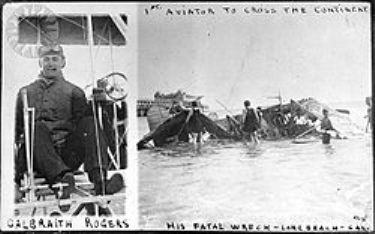 |
Cal Rodgers |
Two pioneer aviators, Calbraith "Cal" Rodgers and
Charles A. Lindbergh, played prominent roles in the background history of the
W.K. Kellogg Airport. In 1911, less than eight years after the Wright Brothers
made their historic flight at Kitty Hawk, Cal Rodgers became the first pilot to
fly coast-to-coast. On September 17th Rodgers started from Sheepshead Bay, New
York in a competition to win a $50,000 prize offered by William Randolph Hearst
to anyone who could fly coast-to-coast in 30 days or less. No one won the
prize but Rodgers was the only pilot to complete the flight which lasted 49
days and ended at Pasadena at 4:08 p.m. on November 5, 1911 (Harris, 1964,
p.81). His final stop before Pasadena was a landing at Newton's field, west of
Pomona, the afternoon of November 5th to refuel and check his engine
("First Trans-Continental Aviator," 1911). Cal Rodgers was killed on
April 3, 1912 near Long Beach when his plane hit a flock of sea gulls and
plunged into the ocean. To honor the accomplishment of Rodgers the Kellogg
Airport beacon was named the Rodgers Beacon and the field was dedicated to his
memory.
Bryan Daily Eagle
Bryan, Texas
October 17, 1911
AVIATOR RODGERS AT POTTSBORO
Ignored Contract with Denison Firm and They Wouldn't Sell Him Gasoline
(By Associated Press)
Denison,
Texas, Oct. 17 - Aviator Rodgers alighted near Pottsboro, seven miles
north of Denison, at 9:30 a.m. this morning. A lack of gasoline
caused him to stop and inability to get gasoline kept him there with
prospects of a long delay. The firm which had agreed to supply
him gasoline refused to do so because he did not light in Denison.
The firm had a wagon waiting all yesterday and they were vexed
when he flew over their heads. He left McAlester at 7:30 a.m.
Rodgers left Pottsboro for Fort Worth about noon, having secured gasoline from a special train.
LOST HIS WAY
(By Associated Press)
Fort
Worth, Texas, Oct. 17 - Aviator Rodgers lost his way and is going
toward Wichita Falls. Efforts are made in every town to attract
his attention and turn him toward Fort Worth.

Historical Marker
Pottsboro, Grayson Co., Texas
In
March 1911, he visited John at the Wright Company factory and flying
school in Dayton, Ohio and became interested in aviation. He received
90 minutes of flying lessons from Orville Wright, and on August 7,
1911, he took his official flying examination at Huffman Prairie and
became the 49th aviator licensed to fly by the Federation Aeronautique
International. He was one of the first civilians to purchase a
Wright Flyer.
 US Map courtesy of Sherman Museum
US Map courtesy of Sherman Museum
Cross Country Flight

Texas State Historical Association. The Southwestern Historical Quarterly, Volume 65, July 1961 - April, 1962. Austin, Texas. The Portal to Texas History. http://texashistory.unt.edu/ark:/67531/metapth101195/. Accessed February 6, 2016.
Publisher William Randolph Hearst offered the Hearst prize,
US $50,000 to the first aviator to fly coast to coast, in either
direction, in less than 30 days from start to finish. Rodger had
J. Ogden Armour, of Armour and Company, sponsor the flight, and in
return he named the plane, a Wright Model EX designed for exhibition
flights, after Armour's grape soft drink Vin Fiz.
Rodgers
left from Sheepshead Bay, New York, on September 17, 1911, at 4:30 p.m.
He reached Chicago on October 9, 1911. It was decided to
avoid the Rocky Mountains, he would take a southerly route, flying
south through the Midwest until reaching Texas. He turned west
after reaching San Antonio. On November 5, 1911, he landed at
Tournament Park in Pasadena, California, at 4:04 pm in front of 20,000
people. He had missed the prize deadline by 19 days. On
December 10, 1911, he landed in Long Beach, California, and taxied his
plane into the Pacific Ocean. He had carried the first
transcontinental U.S. Mail pouch. The trip required 70 stops, and
he paid the Wright brothers' technician, Charlie Taylor, $70 a week to
be his mechanic. Taylor followed the flight by train and
performed maintenance for the next day's flight. The next
transcontinental flight was made by Robert G. Fowler.
DEATH
On
April 3, 1912, while making an exhibition flight over Long Beach,
California, he flew into a flock of birds, causing the plane to crash
into the ocean. His neck was broken and his thorax damaged
by the engine of the airplane. He died a few moments later, a few
hundred feet from where the Vin Fiz ended its transcontinental flight.
The aircraft in this last flight was the spare Model B
he had carried in the special train during the transcontinental flight,
rather than the Vin Fiz. The Vin Fiz itself was later given to
the Smithsonian Institution
by Galbraith's widow, Mabel Rodgers. According to contemporary
records, his was the 127th airplane fatality since aviation began and
the 22nd American aviator to die in an accident. He was also the
first pilot who fatally crashed as a result of a bird strike.
RODGERS ENDS PACIFIC FLIGHT OF 4,231 MILES
Flyer, Who Left Here September 17 in Hearst Contest, Wildly Welcomed in Pasadena
HE IS ALMOST CRUSHED
Fully Ten Thousand Men and Women in Mad Rush to Bi-Plane as It Touches Down
by Otheman Stevens
Pasadena,
California, November 5 - A few minutes after 4 o'clock this afternoon,
Calbraith P. Rodgers was sighted by a small boy on top row of the
bleachers at Tournament Park.
"There
he comes!" yelled the youngster, thereby announcing to the world that
the greatest aviation feat of the century had been completed: that
Rodgers had crossed the continent with a record of something like 4,000
miles in 50 days in a Wright biplane.
A
world's record had been established. Rodgers was the first man to
do this wonder - to drive an airship from ocean to ocean - and together
with the howling small boy on the bleachers, 10,000 or 12,000 men and
women went crazy with the joy of it.
No
one noted the exact time of Rodger's alighting except the official
timekeeper. I did not because I was in the centre of a maelstrom
of fighting, screaming, out-of-their-minds-with-joy men, women and
children.
STRAIGHT AS THE CROW FLIES
Far
to the southeast a pin point appeared in the sky; that was when the
youngster's shrill yell was heard. Gradually it grew larger until
the wings of the machine could be picked out against the azure,
evidently following the line of the Southern Pacific track, about 1,500
feet high. Then Rodgers swerved to the northwest and approached
Tournament Park. The assemblage seemed to comprehend what his
advent meant, for in an instant every one seemed to go crazy.
Rapidly,
experts said at a rate of 65 or 70 miles an hour, Rodgers came directly
for the park, and when he arrived overhead of the south end of the
bleachers, he seemed to feel the frenzy of the mass of people below
him, for he began the most fantastic and perilous evolutions I have
ever seen. Paulhan gave us an indication of recklessness, and
poor martyred Hoxsey in his spiral dips and corkscrew landings
delightfully terrorized us at Aviation Park, Los Angeles, but all of
these were as nothing compared to the dangerous feats which Rodgers
performed above our heads.
10,000 RUSH FOR THE MACHINE
Five
or six times he circled the field in this manner and then suddenly
swooped down to the centre field opposite the club cottage.
Meanwhile,
the announcer, with an enormous megaphone, had been hysterically
rushing about the course warning the crowds back from the infield.
A dozen or more of Pasadena's "finest" had stationed themselves
with clubs in hand, ready for a rush. But as soon as the skids of
Rodger's machine touched earth Ready and his megaphone and the entire
police force seemed to be wiped out of existence.
Fully
10,000 people rushed madly for the machine. The policemen got to
their feet, and with club and punches tried their best to hold us back.
Men stumbled and went down and were carelessly trodden as the
wave of humanity swept on.
After Rodgers was rescued the flight back to the grand stand was even more strenuous.
GETS A POSEY FROM FAIR HANDS
The
foreguard surrounded Rodgers, sustaining him on either side. But
the big Chief of Police, who had lost his club, but whose mighty fists
were more efficacious, opened a path for them.
Half
a dozen times I felt my feet squish sickeningly into some flabby person
beneath on the ground, but there was no stopping, and in 20 minutes'
transit of a couple of hundred yards we landed Rodgers in front of the
grand stand.
In
the midst of all the turmoil a motor car containing Mrs. Davis, wife of
the president of the Pasadena Board of Trade, and Miss Irene Grosse had
been kept in readiness at the grand stand. Rodgers was hoisted up
on the footboard of the car and the 2 ladies presented him with a
magnificent posey on the part of the city.
I
noticed when Rodgers alighted he had a cigar in his mouth, and all
through the skirmish he manfully held on to it, but at the sight of the
ladies he threw it away and, I thought, turned a bit pale.
Rodgers has been described to me as a woman hater, but it seems he was simply a woman fearer, for this hero....


Famous & Infamous
Copyright © 2024, TXGenWeb..
If you find any of Grayson County TXGenWeb
links inoperable,
please
send me a message.







